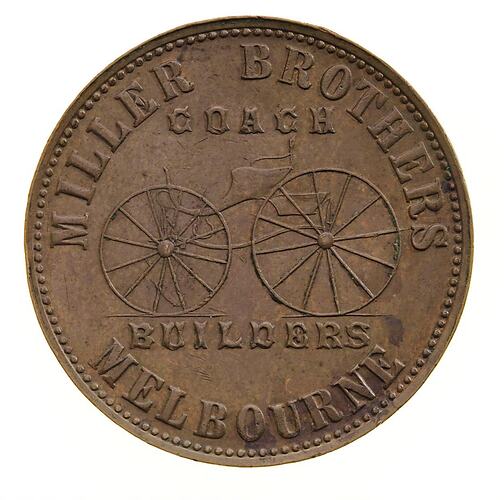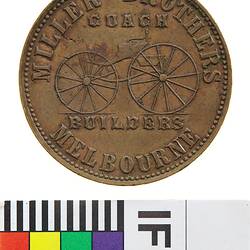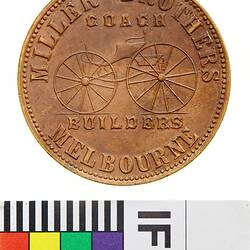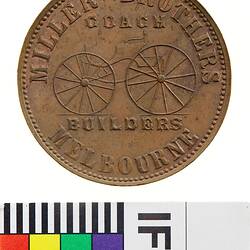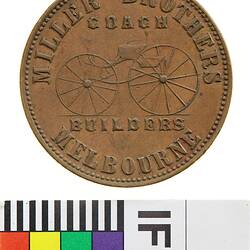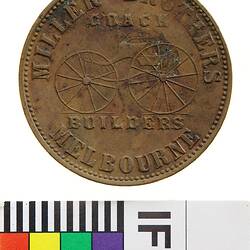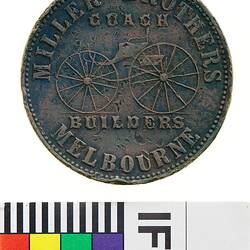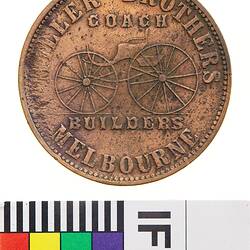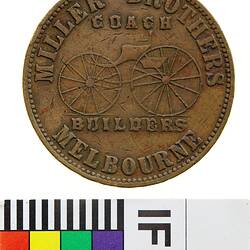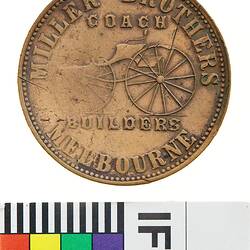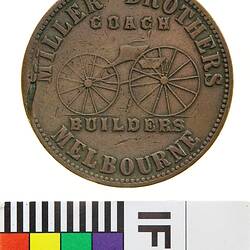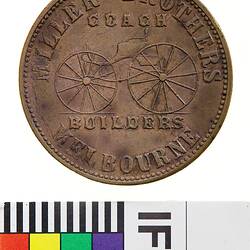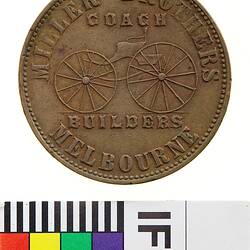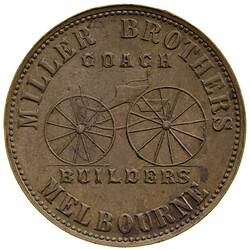The story of the Miller Brothers, Coach Builders, is a story of family success cut short by tragedy.
William Miller, a 24 year-old native of Belfast in Northern Ireland (then the North of Ireland), arrived in Australia in November 1857 on board the Guy Mannering. On board with him was one Nancy Miller, aged 22. As Gardner states, 'by trade he was a coachbuilder, and, deciding to commence business on his own account, secured premises in Russell-street, about midway between Bourke and Little Bourke streets.' After a year or so his two brothers, John and George, joined him in Melbourne. The business, now called Miller Bros., was growing and so they moved to larger premises in Lonsdale Street, where they leased the 'old iron building.previously known as the Lyceum Theatre'. (Gardner, 1911)
Melbourne's commercial directories present a slightly different chronology, and a different cast. The first listing for a coach builder by the name of William Miller is in 1859 when 'Miller Brothers, coach builders, 121 Russell Street' appeared in Sands and Kenny's Melbourne directory. They remained at this address untill 1862, and the following year they moved next door to number 123, and took up number 40 Stephen Street (later Exhibition Street) as well, where they remained for two years. The record for 1863 also included the names of the four brothers in the business: Hercules, William, George and John. In 1865 only three of the brothers were listed - John was absent - and the business moved to 80 Lonsdale Street East, where they remained until 1867. In 1868 Hercules' was the only name associated with the business, and the premises had shifted to 91 Queen Street, where the business remained until at least 1870. William returned to the business in the 1869 listing, and was the sole person associated with the listing in 1870.
The business was advertised through the 1860s. In late 1861 and early 1862 the brothers ran four different two and three-line advertisements in the 'Carriages and other Vehicles' column of the The Argus, drawing the attention of the public to their Phaetons, Gigs, Alberts and Buggies. In 1863 the company took out a full page advertisement in the Sands and McDougall Melbourne Directory which included a pictures of their building in Russell Street, two different styles of buggies, and the notice that 'The undersigned are prepared to supply American and Colonial-made Carriages, manufactured from the best American material, at lowest possible prices. The most useful assortment on Sale, Arriving, and in the course of manufacture at our factory.' In 1869 their advertisement in Sands and McDougall's directory was much simpler. It read 'Miller Brothers, Carriage Builders. Show rooms: 91 Queen Street, Melbourne.'
The brothers did good business together and, according to Gardner, after 'two or three years' George and John went back to the United Kingdom on a trip combining business with bringing their families to Australia. 'They reached the old country safely and embarked on their return journey in the ill-fated ship Lord Raglan, bringing with them, in addition to their wives and one child, three of their sisters. From a letter received by Mr. William Miller, it was learned that the vessel had crossed the line after experiencing some very rough weather, and the letter further stated that they were to have a banquet in celebration of their good fortune. That was the last news of the Lord Raglan, for she never reached port, nor was she ever heard of after.' (Gardner)
Information collected so far indicates that Gardner's story about the sinking of the Lord Raglan is possible, but it has not positively been determined to be true. The Argus reported on 12 February 1864, page 5, that a J. Miller 'and his family' had indeed been lost on the Lord Raglan ( a William Alex Miller was among other passengers lost) - though with no mention of a George Miller. The list was drawn from a passenger list given to the Australasian Gazette on 21 November 1863. One of the final letters from a passenger was published in the Argus, 19 April 1864, page 6. It notes that the ship crossed the equator on 23 March 1863 (the last date it was heard of, by a passing ship). It had encountered a terrible storm, confirming Gardner's account, with 'men and women shrieking, crying and praying on all sides...we expected that that ship would founder and that we should all be lost'. The chief mate's leg was broken. The correspondent was very disparaging of his or her fellow passengers: 'if England, Ireland and Scotland had been searched through, a worse lot could not have been found. I have seen and heard much, but I have never heard such language in my life; the oaths and curses are dreadful. If we arrive safe in Melbourne it will be a miracle.'
No miracle occured. After his family members failed to arrive, William Miller left Melbourne, and started another coach building business, this time in Bendigo. He ran his business there for 20 years before returning to Melbourne and establishing business in City Road, South Melbourne. William Miller died on 30 October 1910. His wife predeceased him, but he was survived by four sons and two daughters.
Miller Bros. issued four tokens, with two upsets, struck for them by Thomas Stokes in 1862, using his standard sets of reverses, but including a fine engraving of a buggy on the obverse, making this one of the more decorative of Stokes' 1862 tokens.
References:
Gardner, F. (1911). "Trade tokens and the firms who issued them", The Australian Storekeepers and Traders Journal, 31 May, pp.13-14.
Internet index to Unassisted Immigrants to Victoria from British Ports. VPRS 7666.
Sharples, J. (1993). "Catalogue of Victorian Trade Tokens", Journal of the Numismatic Association of Australia. Vol.7., December, pp.50-51.
Advertisement, The Argus, 22 November 1861. p.8
Advertisement, Sands and McDougall's Commercial and General Melbourne Directory for 1863. Advertisements: p.34.
Advertisement. Sands and McDougall's Commercial and General Melbourne Directory for 1869. Advertisements: p.42.
Hope, John (2005). 'Miller Brothers', unpublished MSS, 2 pps.
The Argus
More Information
-
Keywords
-
Localities
-
Authors
-
Article types
